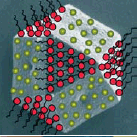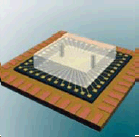Refine search
Actions for selected content:
106069 results in Materials Science
Effect of ultraviolet cure on the interfacial toughness and structure of SiOC thin film on Si substrate
-
- Journal:
- Journal of Materials Research / Volume 25 / Issue 10 / October 2010
- Published online by Cambridge University Press:
- 31 January 2011, pp. 1910-1916
- Print publication:
- October 2010
-
- Article
- Export citation
Synchrotron x-ray μ-tomography to model the thermal radiative properties of an opaque ceramic coating at T = 1000 K
-
- Journal:
- Journal of Materials Research / Volume 25 / Issue 10 / October 2010
- Published online by Cambridge University Press:
- 31 January 2011, pp. 1890-1897
- Print publication:
- October 2010
-
- Article
- Export citation
Quality control of epitaxial LiCoO2 thin films grown by pulsed laser deposition
-
- Journal:
- Journal of Materials Research / Volume 25 / Issue 10 / October 2010
- Published online by Cambridge University Press:
- 31 January 2011, pp. 1886-1889
- Print publication:
- October 2010
-
- Article
- Export citation
Preview: 2010 Materials Research Society Fall Meeting & Exhibit
-
- Journal:
- MRS Bulletin / Volume 35 / Issue 10 / October 2010
- Published online by Cambridge University Press:
- 31 January 2011, pp. 804-813
- Print publication:
- October 2010
-
- Article
-
- You have access
- Export citation
Upcoming Articles
-
- Journal:
- MRS Bulletin / Volume 35 / Issue 10 / October 2010
- Published online by Cambridge University Press:
- 12 September 2016, p. 816
- Print publication:
- October 2010
-
- Article
-
- You have access
- Export citation
Investigation of a ductile and corrosion-resistant Pd79Au1.5Ag3Si16.5 bulk metallic glass
-
- Journal:
- Journal of Materials Research / Volume 25 / Issue 10 / October 2010
- Published online by Cambridge University Press:
- 31 January 2011, pp. 1943-1949
- Print publication:
- October 2010
-
- Article
- Export citation
Formation of maghemite nanoparticles in bismuth telluride materials containing iron
-
- Journal:
- Journal of Materials Research / Volume 25 / Issue 10 / October 2010
- Published online by Cambridge University Press:
- 31 January 2011, pp. 2042-2046
- Print publication:
- October 2010
-
- Article
- Export citation
Erratum: Corrigendum to “Thermochemistry of glass forming Y-substituted Sr-analogues of titanite (SrTiSiO5)” [J. Mater. Res. 24(11), 3380 (2009)]
-
- Journal:
- Journal of Materials Research / Volume 25 / Issue 10 / October 2010
- Published online by Cambridge University Press:
- 31 January 2011, pp. 2054-2055
- Print publication:
- October 2010
-
- Article
-
- You have access
- Export citation
Energy Focus: Nanocomposites improve performance of electrode materials for Li-ion batteries
-
- Journal:
- MRS Bulletin / Volume 35 / Issue 10 / October 2010
- Published online by Cambridge University Press:
- 31 January 2011, p. 733
- Print publication:
- October 2010
-
- Article
-
- You have access
- Export citation
Electrochemical synthesis of inorganic polycrystalline electrodes with controlled architectures
-
- Journal:
- MRS Bulletin / Volume 35 / Issue 10 / October 2010
- Published online by Cambridge University Press:
- 31 January 2011, pp. 753-760
- Print publication:
- October 2010
-
- Article
- Export citation
Crystal orientation of β-Sn grain in Ni(P)/Sn–0.5Cu/Cu and Ni(P)/Sn–1.8Ag/Cu joints
-
- Journal:
- Journal of Materials Research / Volume 25 / Issue 10 / October 2010
- Published online by Cambridge University Press:
- 31 January 2011, pp. 1950-1957
- Print publication:
- October 2010
-
- Article
- Export citation
Nanomaterials for cross-reactive sensor arrays
-
- Journal:
- MRS Bulletin / Volume 35 / Issue 10 / October 2010
- Published online by Cambridge University Press:
- 31 January 2011, pp. 797-803
- Print publication:
- October 2010
-
- Article
- Export citation
Effect of frame stiffness on the deformation behavior of bulk metallic glass
-
- Journal:
- Journal of Materials Research / Volume 25 / Issue 10 / October 2010
- Published online by Cambridge University Press:
- 31 January 2011, pp. 1958-1962
- Print publication:
- October 2010
-
- Article
- Export citation
Tensile deformation of anisotropic porous copper with directional pores
-
- Journal:
- Journal of Materials Research / Volume 25 / Issue 10 / October 2010
- Published online by Cambridge University Press:
- 31 January 2011, pp. 1975-1982
- Print publication:
- October 2010
-
- Article
- Export citation
Solution chemistry effects on cracking and damage evolution during chemical-mechanical planarization
-
- Journal:
- Journal of Materials Research / Volume 25 / Issue 10 / October 2010
- Published online by Cambridge University Press:
- 31 January 2011, pp. 1904-1909
- Print publication:
- October 2010
-
- Article
- Export citation
Experimental study of grain refinement mechanism in undercooled Ni–15at.%Cu alloy
-
- Journal:
- Journal of Materials Research / Volume 25 / Issue 10 / October 2010
- Published online by Cambridge University Press:
- 31 January 2011, pp. 1963-1974
- Print publication:
- October 2010
-
- Article
- Export citation
Meet Our Authors
-
- Journal:
- MRS Bulletin / Volume 35 / Issue 10 / October 2010
- Published online by Cambridge University Press:
- 12 September 2016, pp. 751-752
- Print publication:
- October 2010
-
- Article
-
- You have access
- Export citation
Production of granulated-copper oxide nanoparticles for catalytic application
-
- Journal:
- Journal of Materials Research / Volume 25 / Issue 10 / October 2010
- Published online by Cambridge University Press:
- 31 January 2011, pp. 2025-2034
- Print publication:
- October 2010
-
- Article
- Export citation
Catalyst and catalyst support morphology evolution in single-walled carbon nanotube supergrowth: Growth deceleration and termination
-
- Journal:
- Journal of Materials Research / Volume 25 / Issue 10 / October 2010
- Published online by Cambridge University Press:
- 31 January 2011, pp. 1875-1885
- Print publication:
- October 2010
-
- Article
- Export citation
Normal modes and density of states achieved in disordered colloidal solids
-
- Journal:
- MRS Bulletin / Volume 35 / Issue 10 / October 2010
- Published online by Cambridge University Press:
- 31 January 2011, pp. 734-735
- Print publication:
- October 2010
-
- Article
-
- You have access
- Export citation


